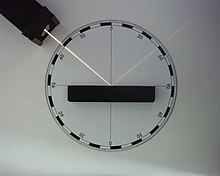|
Luster (textiles) In textiles, lustre or luster is a physical property that makes them appear bright, glossy, and shiny. The amount of light reflected from the surface of a fiber is referred to as its luster. The level of luster is determined by how light reflects off the surface. For example, round surfaced fiber reflects more light and appears shinier than fiber with an irregular surface. Synthetic fibers with a more regular surface seem brighter than natural fibers with an irregular surface, with the exception of silk, which has a regular surface.[1][2][3][4] ObjectiveLuster is the degree of gloss or sheen possessed by the fiber or textile surface. Luster adds aesthetic values in fabrics, contributes to their attractiveness. Occasionally, this adds value to their quality assessment.[2][4] In some cases, when lustre is undesirable, fibres are purposefully dulled by the addition of substances.[1]: 73 Factors Factors affecting ''lustre (the way light reflects)'' lie with fiber properties, but various processes can also alter the surface of textiles and transform the fabric luster. Surface manipulation has a significant impact on light reflection. Rough surfaces absorb and scatter light, while neat and clean surfaces reflect more light. LusteringFiber structureCrystalline structured fibers possess a higher luster than the amorphous structure. Secondly smooth surface and cross section of the fiber plays a vital role in reflecting the light. The rounded edges and triangular cross section of the silk fiber contribute to its luster properties; in some cases, synthetic fibres mimic this trilobal shape for a silk-like appearance.[5] Finishes'Lustering' refers to any process that uses steam, heat, or pressure to enhance the lustre.[6] Other than fiber structure, it is chemical orientation and different finishing methods such as singeing, heat-setting, calendering, silk surfacing, mercerizing, and bio polishing, etc.[1][7]
Luster describing terms
DelusteringIn opposite delustrant, the substances that reduce the luster are added in synthetic fibers. As their names imply, they can be described as "clear," "bright," "dull," "semi-dull," "extra dull," and "super dull" with regards to the amount of luster. [1][3]Scattering and absorbing light tends to cause the fibre to appear duller because of the delustrating additive, such as titanium dioxide.[10] Luster indexEarlier, there was ambiguity in the results of luster in textiles. A new approach has been developed to analyze the luster through images. Devices can measure luster in textiles by analyzing the luminance of images taken from various angles.[11] See also
References
|